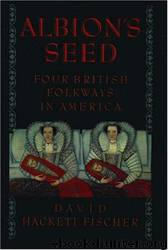Albion's Seed by David Hackett Fischer

Author:David Hackett Fischer
Language: eng
Format: mobi, epub
ISBN: 9780195069051
Publisher: Oxford University Press
Published: 1991-01-02T00:00:00+00:00
Penrith Beacon stands high on a hill near the Cumbrian town of the same name. Its purpose was to warn the English countryside when Scottish raiders were over the border. Many such beacon towers were constructed throughout this turbulent region. Several had earlier stood on the site where this one was constructed of a local red sandstone in 1715, the year of the Scottish Jacobite rising. It was used in 1745 during the last Scottish invasion of England. The Penrith Beacon still stands today, a monument to many centuries of violence in the borderlands. This drawing follows two illustrations, kindly supplied by the Penrith Library.
the Tyneside often did as much killing in relation to the local population as the plague did nearly everywhere.”5 The cultural effect of violence was magnified by a climate of fear which continued even in periods of peace. Long after the “Forty-five,” English diaries often recorded rumors that the Scots were “over the borders.” Fear itself remained a social fact of high importance after so many centuries of strife.6
Dynastic stuggles between the monarchs of England and Scotland were only a small part of the border’s sufferings. The quarrels of kings became a criminal’s opportunity to rob and rape and murder with impunity. On both sides of the border, and especially in the “debatable land” that was claimed by both kingdoms, powerful clans called Taylor, Bell, Graham and Bankhead lived outside the law, and were said to be “Scottish when they will, and English at their pleasure.”7 They made a profession of preying upon their neighbors—“reiving,” it was called along the border.8 Other families specialized in the theft of livestock—“rustling” was its border name. Rustling on a small scale was endemic throughout the region. Large gangs of professional rustlers also “operated on a scale more reminiscent of the traditional American model than any English equivalent,” in the words of an historian.9
This incessant violence shaped the culture of the border region, and also created a social system which was very different from that in the south of England. On the border, forms of tenancy were designed to maintain large bodies of fighting men. Lord Burghley noted, “ …there is no lease in that country, but with provision to find horse and arms, to be held by an able man.”10 In the great manors of Wark and Harbottle, it was observed that “customary tenure was very secure … descent was by partible inheritance, so that potential fighting men were guaranteed subsistence.”11
Download
This site does not store any files on its server. We only index and link to content provided by other sites. Please contact the content providers to delete copyright contents if any and email us, we'll remove relevant links or contents immediately.
| African-American Studies | Asian American Studies |
| Disabled | Ethnic Studies |
| Hispanic American Studies | LGBT |
| Minority Studies | Native American Studies |
Cecilia; Or, Memoirs of an Heiress — Volume 1 by Fanny Burney(31564)
Cecilia; Or, Memoirs of an Heiress — Volume 3 by Fanny Burney(31103)
Cecilia; Or, Memoirs of an Heiress — Volume 2 by Fanny Burney(31051)
The Great Music City by Andrea Baker(26693)
We're Going to Need More Wine by Gabrielle Union(18237)
Bombshells: Glamour Girls of a Lifetime by Sullivan Steve(13261)
Pimp by Iceberg Slim(13150)
All the Missing Girls by Megan Miranda(13035)
Fifty Shades Freed by E L James(12572)
Talking to Strangers by Malcolm Gladwell(12183)
Norse Mythology by Gaiman Neil(12123)
Crazy Rich Asians by Kevin Kwan(8490)
Mindhunter: Inside the FBI's Elite Serial Crime Unit by John E. Douglas & Mark Olshaker(8060)
The Lost Art of Listening by Michael P. Nichols(6672)
Enlightenment Now: The Case for Reason, Science, Humanism, and Progress by Steven Pinker(6537)
Bad Blood by John Carreyrou(5895)
The Four Agreements by Don Miguel Ruiz(5716)
Weapons of Math Destruction by Cathy O'Neil(5231)
We Need to Talk by Celeste Headlee(5041)
